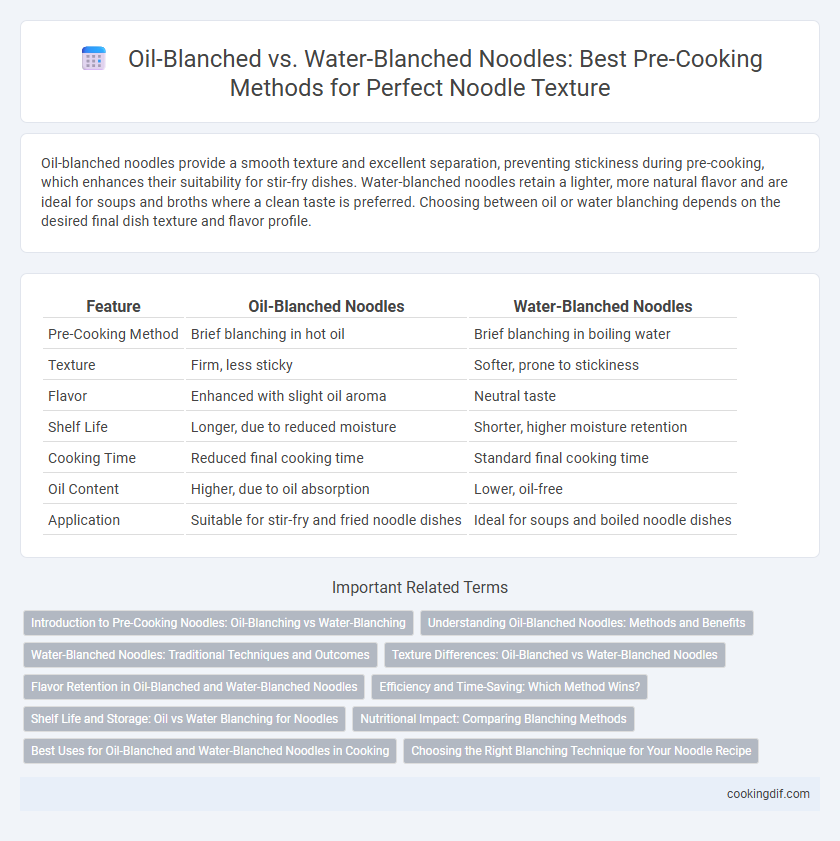Oil-blanched noodles provide a smooth texture and excellent separation, preventing stickiness during pre-cooking, which enhances their suitability for stir-fry dishes. Water-blanched noodles retain a lighter, more natural flavor and are ideal for soups and broths where a clean taste is preferred. Choosing between oil or water blanching depends on the desired final dish texture and flavor profile.
Table of Comparison
| Feature | Oil-Blanched Noodles | Water-Blanched Noodles |
|---|---|---|
| Pre-Cooking Method | Brief blanching in hot oil | Brief blanching in boiling water |
| Texture | Firm, less sticky | Softer, prone to stickiness |
| Flavor | Enhanced with slight oil aroma | Neutral taste |
| Shelf Life | Longer, due to reduced moisture | Shorter, higher moisture retention |
| Cooking Time | Reduced final cooking time | Standard final cooking time |
| Oil Content | Higher, due to oil absorption | Lower, oil-free |
| Application | Suitable for stir-fry and fried noodle dishes | Ideal for soups and boiled noodle dishes |
Introduction to Pre-Cooking Noodles: Oil-Blanching vs Water-Blanching
Pre-cooking noodles through oil-blanching involves briefly frying the noodles in hot oil, which enhances texture and prevents sticking by creating a protective coating. Water-blanching, by contrast, cooks noodles in boiling water to soften them without adding fat, ideal for maintaining a lighter product. Choosing between oil-blanching and water-blanching depends on the desired noodle texture, shelf life, and culinary application.
Understanding Oil-Blanched Noodles: Methods and Benefits
Oil-blanched noodles undergo a cooking process where they are briefly boiled and then tossed in hot oil, which helps prevent clumping and extends shelf life by reducing moisture. This method enhances texture by maintaining noodle elasticity and imparts a slightly glossy appearance, making them ideal for quick stir-fry dishes. Compared to water-blanched noodles, oil-blanched varieties require less immediate reheating and provide improved convenience and flavor retention in pre-cooked meals.
Water-Blanched Noodles: Traditional Techniques and Outcomes
Water-blanched noodles undergo a traditional pre-cooking method that maintains a softer texture and subtle flavor, optimizing absorbency for sauces and broths. This technique preserves the noodle's elasticity and reduces oil residue, resulting in a cleaner taste profile favored in delicate Asian noodle dishes. The natural hydration process also enhances the noodle's structural integrity, making it ideal for stir-frying and soups requiring rapid cooking.
Texture Differences: Oil-Blanched vs Water-Blanched Noodles
Oil-blanched noodles maintain a firmer, more elastic texture due to the thin oil coating that prevents stickiness and moisture loss during storage. Water-blanched noodles tend to have a softer, slightly sticky surface, which can result in a less chewy mouthfeel after reheating. The oil-blanching method enhances overall noodle resilience, making it preferable for dishes requiring reheated or delayed consumption.
Flavor Retention in Oil-Blanched and Water-Blanched Noodles
Oil-blanched noodles retain more flavor due to the oil coating that prevents the leaching of starches and nutrients during pre-cooking, enhancing taste and texture. Water-blanched noodles tend to lose more flavor as water extracts soluble compounds, resulting in a milder taste profile and softer texture. For culinary applications prioritizing rich flavor retention, oil blanching is the preferred pre-cooking method.
Efficiency and Time-Saving: Which Method Wins?
Oil-blanched noodles offer superior efficiency in pre-cooking by preventing noodles from sticking together, reducing the need for additional rinsing and handling time compared to water-blanched noodles. The oil coating enhances heat retention during storage, allowing for faster reheating and serving, which significantly cuts down overall preparation time. Water-blanching, while simpler, often requires extra separation steps and longer cooling periods, making it less time-efficient for high-volume noodle preparation.
Shelf Life and Storage: Oil vs Water Blanching for Noodles
Oil-blanched noodles typically exhibit a longer shelf life due to the oil's protective barrier, which reduces moisture loss and inhibits microbial growth. Water-blanched noodles require refrigeration and have a shorter refrigerated shelf life because they retain higher moisture content, increasing susceptibility to spoilage. Proper storage of oil-blanched noodles at room temperature can extend usability up to several weeks, while water-blanched noodles generally need to be consumed within a few days to maintain quality.
Nutritional Impact: Comparing Blanching Methods
Oil-blanched noodles retain higher levels of water-soluble vitamins and improve texture by forming a protective coating that reduces nutrient leaching during cooking. Water-blanched noodles often experience greater nutrient loss, especially B vitamins and antioxidants, due to direct exposure to hot water. Selecting oil blanching enhances nutritional retention and extends shelf life, benefiting both commercial production and consumer health.
Best Uses for Oil-Blanched and Water-Blanched Noodles in Cooking
Oil-blanched noodles retain a firmer texture and resist sticking, making them ideal for stir-frying and cold noodle salads where individual noodle separation is crucial. Water-blanched noodles absorb sauces more effectively and soften evenly, perfect for soups, hot pots, and dishes requiring a tender consistency. Chefs often choose oil-blanched noodles to maintain shape in quick-cook recipes, while water-blanched varieties excel in brothy or stew-based meals.
Choosing the Right Blanching Technique for Your Noodle Recipe
Oil-blanched noodles provide a smoother texture and enhanced flavor retention by coating the noodles with a thin layer of oil that prevents sticking and moisture loss during pre-cooking. Water-blanched noodles offer a cleaner taste profile and reduce oil content, making them suitable for lighter dishes or health-conscious recipes. Selecting between oil-blanching and water-blanching depends on the desired texture, flavor intensity, and nutritional goals of your noodle recipe.
Oil-blanched noodles vs water-blanched noodles for pre-cooking Infographic

 cookingdif.com
cookingdif.com